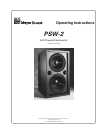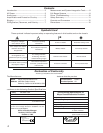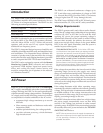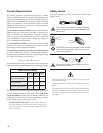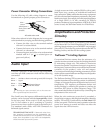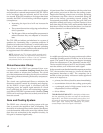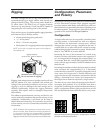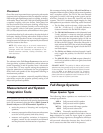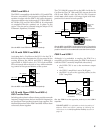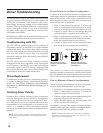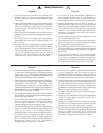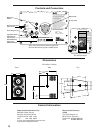
8
Placement
One of the most important factors governing subwoofer
response is their placement relative to adjacent surfaces.
Subwoofers gain significant power by coupling, or loading,
with nearby floors and walls. Half-space loading describes
a speaker coupling with one surface. Subs placed on
the floor benefit from half-space loading, while flown
subs in free-space (without a nearby wall or ceiling) do
not. In general, subs in half-space generate twice the
SPL (+6 dB) compared to the same number in free-space.
It can be beneficial to fly subwoofers, despite the lack of
half-space loading. Placing subwoofers within a flown
cluster of mid-hi speakers creates a smooth frequency
image because the subs are not separated by the distance
from the cluster to the floor.
NOTE: SPL values refer to an on-axis measurement
position. The actual SPL addition and narrowing of
coverage varies with frequency and depends on the
distance between cabinets, loading conditions, and
room acoustics.
Polarity
The cabinets in the
Full-Range Systems
section
are in a
close-proximity coplanar orientation, unless otherwise
stated. Separating a mid-hi speaker from a subwoofer
by more than 5 ft may require setting the speakers to
opposite polarities to compensate for the propagation
delay from each speaker to the designated listening or
measurement position.
In a coplanar orientation, externally amplified Meyer
subwoofers require the opposite polarity setting to all
Meyer self-powered speakers.
Measurement and System
Integration Tools
It is essential that even the most carefully assembled
sound systems be analyzed with precise measurement
tools. We recommend using the Meyer SIM® System II
Sound Analyzer and CP-10 Parametric Equalizer to
• assist the process of choosing and configuring
speakers;
• measure propagation delays between subsystems
to set the correct polarity and delay times;
• measure and equalize variations in frequency
response caused by the acoustical environment
and the placement and interaction of speakers.
We recommend using the Meyer LD-1A Line Driver to
integrate different types of Meyer self-powered speakers
into a complete system. The LD-1A has two channels
equipped to control a full-range main system, and six
auxiliary channels for down-fill, front-fill, and delay
systems. The LD-1A maintains signal integrity for long
cable paths and provides the following useful functions:
• The Lo Cut switch activates a high-pass filter
(160 Hz, –12 dB/oct, Q = 0.8) that performs a
crossover function for the Mid-Hi output.
• The DS-2 & Sub Crossover switch (channels 1 and
2 only) activates a crossover network optimized
for the DS-2P when used with the PSW-2 or 650-P.
With the switch in, frequencies below 80 Hz are
sent to the Sub output (for the 650-P), and above
80 Hz to the DS-2 output. When the subwoofer is
used without the DS-2P, the switch should be out,
which sends a full-range signal to both the DS-2
and Sub outputs.
• The DS-2 φ and Sub φ switches (channels 1 and 2
only) toggle the polarity for the DS-2 and Sub
outputs.
• The Mid-Hi, DS-2, and Sub outputs (channels 1
and 2 only) each have their own gain control and
mute switch.
POLARITY NOTE: The polarity for Meyer self-powered
speakers may be reversed using the input polarity switch
on the user panel. The LD-1A also allows polarity reversal
with the
DS-2 φ
and
Sub φ
switches for speakers
connected to the DS-2 and Sub outputs. When making
polarity decisions in applications that include the LD-1A,
check the state of all polarity switches.
Full-Range Systems
Meyer Speaker Types
The following Meyer speakers are mentioned in the
example applications.
MSL-4 Self-powered mid-hi speaker
CQ Series Self-powered mid-hi speaker
MTS-4 Self-powered full-range speaker
650-P Self-powered subwoofer
USW-1 Externally amplified subwoofer
The Meyer self-powered speakers listed above have a
loop connection to send the input signal to another
speaker. Full-range signals may be applied to all Meyer
self-powered subwoofers because they have built-in
active crossovers that filter mid-hi frequencies.



